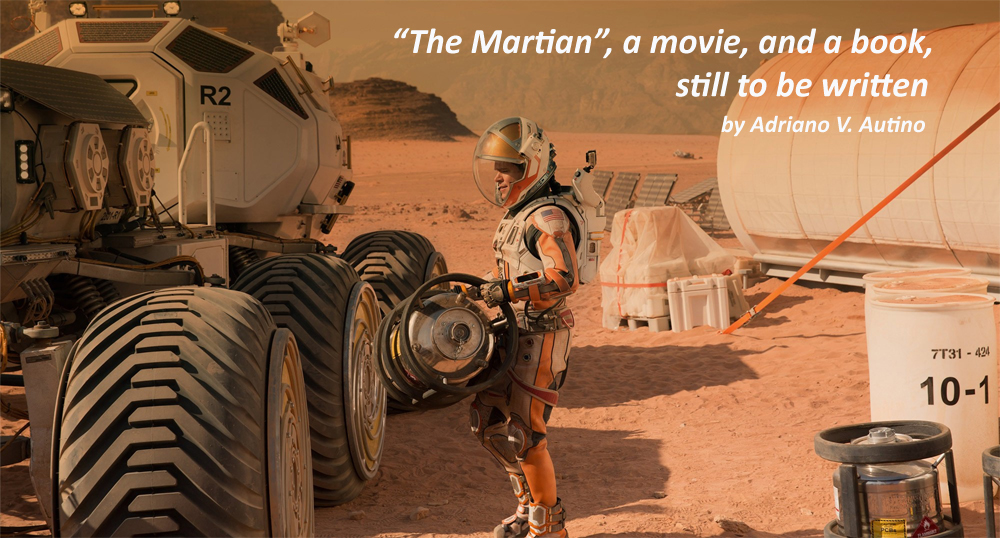SRI NEWSLETTER – OCTOBER 20th 2015 – by A. V. Autino
There’s never time to write and comment on everything worthy of comment, however “The Martian” (in Italian, “Il sopravvissuto”) gives me the opportunity to put on paper some concepts very central to my space activist sensitivity.
First of all, I will say that I would like very much to see an exploration mission to Mars, and I could also say that I’d like to have seen it some years ago, and now to be witness to its initial settlements. This is a first point of discussion: many will say that the technologies are not mature enough. I would reply that technologies to go to the Moon simply didn’t exist in 1961, when President Kennedy challenged NASA to reach our natural satellite within ten years. So please let’s not listen too much to the ones who make things even more difficult than they are, in order to “raise the price” of their supply.
Having said that, I have to say that the book written by Andy Weir is much better than the movie, from the point of view of the novel: we listen to Mark Watney, his desperation, his hopes, his continuous reasoning on the practical problems he does his best to solve, by his skills of as an astronaut and botanist. And, most of all, the book is a manifesto of the human initiative, and capacity to never give up. The book also gives us the measure of how much Mars needs to be explored, in order to understand the conditions in which the first settlers will find themselves. This is something that the movie doesn’t convey, or, if it does, in a reduced measure.
Coming to the policy aspects, the book and the movie were released just before NASA was presenting its budget to the Congress. At the same time, NASA announced the discovery of liquid water flowing on Mars, albeit seasonally. The mission statement of NASA is space exploration and it is entirely appropriate to justify an agency’s proposed budget by highlighting achievements that demonstrate the mission is being accomplished. They have done so repeatedly and with savvy marketing capability: chapeau! (said without irony :-). The message is quite clear, and it is repeated several times during the movie: the goal is to do exploration missions, and always to bring the explorers back to home, on Earth.
Not by chance, the end of the movie is quite different from the end of the book. The last lines of the book are taken from the board logbook, Mission Day 687. Mark questions why such a significant amount of money was spent to rescue him, one only person, instead of abandoning him on Mars’ surface. Beyond the humanitarian rationales, he mentions “progress, science and the interplanetary future that we dream since centuries”. The last scenes of the movie show us Mark, considering a green, small plant spontaneously growing among stones on Earth and, subsequently, giving an education to young candidate explorers, illustrating the very hard conditions of space. The subliminal message seems very clear to me: let’s continue to empower trained explorers to go to Mars, while the rest of us remain “safe” (so to say) on Earth. During the credits, we listen to the announcement of NASA about next exploration mission, reiterating the concept: the goal is to bring the explorers back to home, to Earth. So, even “ordinary” viewers of the movie, fully unaware of any space policy, could ask: but why are we going there, if we don’t want to stay, and to settle on another planet for human benefit? To address that question, I’d like to submit few reflections those who promote Mars colonization and spacefaring civilization.
First, are we sure that, in 2030, should the only space strategy remain exploration, we will have resources and funds to re-purpose an Apollo-style program to Mars? Considering the social, economical and environmental situations that could be logically anticipated, considering that likely in 2030 we will be 9 or 10 billions people on Earth, I have many doubts. Only expanding our industrial development beyond the limits of our mother planet we can hope to revert the global crisis, and to ignite the greatest economic and cultural revolution of all times. So, why should we just keep on exploring, and not to start expanding? And, talking about expansion, what are the logical first steps? Industrializing the geo-lunar space region, of course, the so called Greater Earth, including the Earth’s orbit, the Moon, the Lagrange Points and the Near Earth Asteroids crossing in or near such area.
Rick Tumlinson recently wrote an article, titled “How we go to Mars”. This is a good approach to the matter. Nobody wants to discuss whether to go or not to go to Mars. The questions are: with which resources, with what support by people, by public money or by private effort? And, could it be a program forwarded by one only country, or would it be an international cooperation program? My opinion is that we won’t be able to reach Mars in 2030, nor later, if a serious expansion program is not well rooted and in progress. Rick answers the question “why” thusly: to improve science and to expand civilization. And he discusses several possible ways, through the Moon or directly, just to explore or to settle and remain. The extent to which the world is in crisis may be perceived differently, depending on whether one lives east or west of the Atlantic. Maybe many more alternatives seem to be possible, from one’s particular vantage point. I would say that, being the current global expenditure around $1,7 trillions/year, for opposing global terrorism and feeding different conflicts, and the expenditure for space just $25 billions, if the world remains closed we can only expect such a quite immature balance to get worse. Any space exploration mission will be more uncertain, unsafe and insufficiently supported.
Having said that, we can still see the problem in different ways. We could criticize the NASA strategy, still oriented only to space exploration and closed to space expansion and industrialization. But I am afraid that would be an old method, based on opposition, instead of collaboration. In parallel, we can however cautiously applaud the new ESA’s strategy, that includes a quite interesting Moon program, for the years 2020 – 2030, including the building of a first lunar village. Some of the Tumlinson’s questions are ruling, of course: who should finance space exploration, and who should finance space expansion? May we simply split the problem, as apparently the US administration tried to do: exploration by governments, by public money, and industrialization by private ventures? It is not that simple. Such an approach could simply lead to half the agency’s budget, and leave few courageous entrepreneurs fighting alone for the benefit of humanity. Is that correct?
I don’t think so. I believe we should move a few percent of the public expenditure toward the support the civilian astronautic industry. This does not preclude continuation of militaristic (defense) systems; such an high cultural maturity cannot be achieved in few months, nor years. But, considering that civilization is exposed to an incredibly high risk of implosion, if we don’t relaunch the global economy by bootstrapping the space revolution, could the military expenditure be reduced from $1.7 billion to $1.6 billion?
Can we imagine what we could do, should the space budget grow from the current $25 billion/year to $125 billion? We could develop the exploration of Mars, and the expansion into the Greater Earth, accelerating the decrease of the cost to orbit, building infrastructures at L4 and L5, on the Moon, and begin mining Asteroids. The civilian astronautic industry would be boosted, many companies founded, space tourism will take off (literally!), and the global crisis will could be overcome. Missions to Mars will move from a space yard located in L5, and not from Earth: that will be quite different book, with all my respect and appreciation to Andy Weir, and movie.
SPACE, NOT WAR!
The World Congress “Space, Not War!” (https://www.spacenotwar.org/) in preparation for 2016, will propose to the world public opinion the only real alternative to involution of civilization constrained within the boundaries of a physically and philosophically closed world.
This Call for Papers (https://www.spacenotwar.org/call_for_papers.php), still evolving, will be soon opened to abstracts submission.
It is already possible to express interest for the congress, using this Pre-Registration form (https://www.spacenotwar.org/congress_pre-registration.php)
[English review by Susan Singer]
download pdf version here: The Martian, a movie, and a book, still to be written










 Space Renaissance France (French Chapter of SRI)
Space Renaissance France (French Chapter of SRI)  Space Renaissance USA, Inc. (USA Chapter of SRI)
Space Renaissance USA, Inc. (USA Chapter of SRI) Space Renaissance (Italian Chapter of SRI)
Space Renaissance (Italian Chapter of SRI) Space Renaissance Academy
Space Renaissance Academy Space Renaissance Initiative Group
Space Renaissance Initiative Group